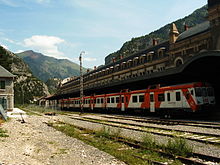Canfranc International railway station
Canfranc International railway station (Spanish: Estación Internacional de Canfranc) is a former international railway station in the village of Canfranc in the Spanish Pyrenees, at one end of the Somport railway tunnel which carried the Pau–Canfranc railway under the Pyrenees. Opened in 1928, the main building is 240 metres (790 ft) long and has 365 windows and 156 doors.
Canfranc | |
|---|---|
The station in July 2015. | |
| Location | Spain |
| Coordinates | 42.75065°N 0.51460°W |
| Elevation | 1,195 metres (3,921 ft) |
| Line(s) |
|
| Construction | |
| Structure type | At-grade |
| History | |
| Opened | 11 July 1928 |
History
Construction of the Somport railway tunnel was inaugurated on the French side on 12 July 1912, and after delays in its construction due to World War I, completed in 1915.
Spanish project engineer Ramírez de Dampierre began construction of the station in 1923, and it was formally opened on 18 July 1928, in the presence of King Alfonso XIII of Spain and the president of the French Republic Gaston Doumergue. The station has 365 windows, and platforms over 200 metres (220 yd) long.[1]
The large size—the second largest station in Europe, known at the time as the "Titanic of the Mountains"—and extensive infrastructure were necessitated in part by the need to transfer all transiting passengers, baggage and freight between Spanish and French trains, because the French rail standard gauge of 1,435 millimetres (4 ft 8 1⁄2 in) was incompatible with the Spanish gauge of 1,668 millimetres (5 ft 5 21⁄32 in) at the time and hence prevented through-traffic.[2] This transformed a simple customs-control exercise into a lengthy logistics exercise.
The site includes a large locomotive depot, two sheds for the transshipment of freight between French and Spanish trains, various other outbuildings and a resultant extensive layout of tracks. Part of the station was considered French territory; a school was established in the village for the children of French staff.[1]
During the Spanish Civil War, Franco had the tunnels sealed on the Spanish side to prevent arms smuggling.[1] But due to the Franco-Spanish international convention under which it was built, the station remained open during World War II. The Spanish authorities came to an operational agreement with the Nazi German Wehrmacht authorities, with freight-trains carrying mined tungsten north and French grain plus trans-shipped Swiss gold south; passenger services also continued, providing an escape route into Spain for some Jews and Allied soldiers.[1]
The station is often said to have been used in the filming of Doctor Zhivago (1965), but although the film was shot largely in Spain, there is no evidence that Canfranc was a location.[3]
The station's reason to exist came to an abrupt halt on 20 March 1970 when a train derailment, on the Pau-Canfranc railway line, demolished the L'Estanguet bridge on the French side of the Pyrénées Mountains. Under financial pressure from French national railway company SNCF, the French government decided not to rebuild the bridge, and hence the cross-border line was closed.[4] The population of the village fell sharply as a result.[1]
Present
_(1).jpg)

The site is mostly overgrown, but most of the buildings are largely intact and can be entered. The main building has been re-roofed, but is otherwise in a state of disrepair, fenced off and closed to the public except during guided tours in July and August. In 2013–17, approximately 120,000 people, mostly Spaniards, toured the station, more than used it when it was in service.[1]
The railway station, using rather more modest facilities, is still open for the two daily passenger trains to and from Zaragoza-Delicias railway station,[1] plus occasional freight trains to the grain silo.
The government of Aragon plans to turn the station into a hotel, build a new station beside it, and reopen the line as the "western trans-Pyrenean line" with the assistance of the government of Aquitaine, the adjacent French region.[1]
See also
References
- Bockman, Chris (1 October 2017). "Is Europe's ghostliest train station about to rise again?". BBC News.
- Alberto García Álvarez (September 2010) [2009]. Automatic Track Gauge Changeover for Trains in Spain (PDF) (4th ed.). Fundación de los Ferrocarriles Espaňoles. ISBN 978-84-89649-56-9.
- Pedro Zapater (1 July 2012). "¿Se rodó 'Doctor Zhivago' en la estación de Canfranc?". Heraldo de Aragón (in Spanish).
- "27 mars 1970: l'accident" (in French). Quierzy Club. Archived from the original on 19 April 2005.
Bibliography
- Dieter Hamblock (2010). "Tristesse in den Pyrenäen" [Sadness in the Pyrenees]. Eisenbahngeschichte (in German). 40: 60–67.
- Alexander Kierdorf (2010). "'Es gibt keine Pyrenäen mehr' – Der Palastbahnhof im spanischen Canfranc" ['There are no more Pyrenees' — The Palace Station in Spanish Canfranc]. Industrie-Kultur (in German). 50 (1): 14–15.
External links
| Wikimedia Commons has media related to Canfranc train station. |
- "Canfranc railway station: in-depth history and pictures". Forbidden Places.
- "Canfranc railway station and Pau line photos and history". Pierre-Henry Muller.
- "Canfrancestacion.com" (in Spanish). Archived from the original on 4 January 2007.
- David Martos (12 October 2013). "Albert Le Lay, el espía que combatió a Hitler desde Canfranc" [Albert Le Lay, the spy who fought Hitler from Canfranc]. ABC (in Spanish). Retrieved 15 December 2013.
- Juego de espías (Canfranc-Zaragoza-San Sebastián) (2013) on IMDb
- El rey de Canfranc (2013) on IMDb
- "Pyrenees Crossing - Snow and Cognac". Berlin 1969.